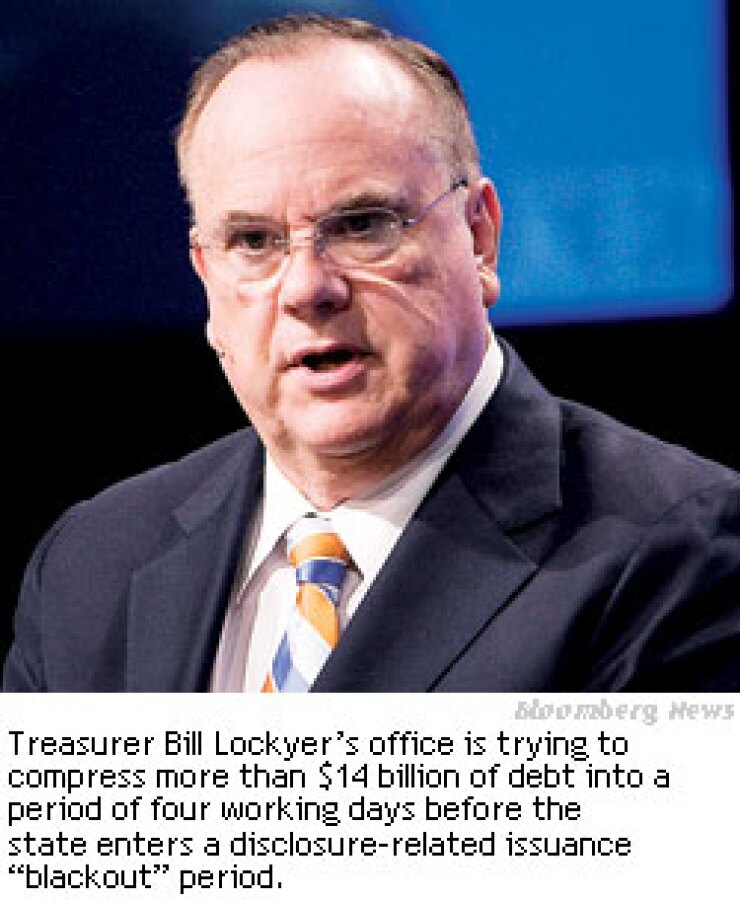
ALAMEDA, Calif. — Facing soaring yields in the tax-exempt bond market, California chopped more than $1 billion from its tax-exempt debt plans for next week, while upsizing today’s Build America Bond pricing by $1.275 billion.
The new schedule now calls for California to price $3.275 billion of taxable GO bonds today. The state previously added $750 million to the BABs sale and Thursday added another $525 million.
The state cut the size of Tuesday’s planned tax-exempt bond deal by $750 million to $1 billion, while another deal for Tuesday, a $267 million lease-revenue bond sale for the California State Public Works Board, was canceled entirely.
A separate, $102 million lease-revenue bond deal for the Public Works Board remains on the calendar for the moment, though it may also be pulled, said Tom Dresslar, spokesman for Treasurer Bill Lockyer.
Friday’s taxable deal will include $3.025 billion of Build America Bonds, for which the state will receive a 35% federal subsidy on the taxable interest it pays to investors.
Given the state of the markets, it makes sense to sell more BABs and fewer tax-exempts, Dresslar said.
“In an environment where tax-exempt yields keep rising, it’s in taxpayers’ best interest that we cut the tax-exempt offering and increase the savings we can achieve with subsidized BABs,” he said. “That way, we can finance critical infrastructure projects, and the jobs they create, while getting a better deal for taxpayers.”
The Treasurer’s Office was in scramble mode throughout Wednesday, as the need to disclose a recently filed lawsuit against the state forced a one-day delay in the pricing of $10 billion of tax-exempt short-term notes, while watching tax-exempt yields continue to rise for the third day in a row.
In the end, the one-day delay landed the state a net gain of $117 million in new retail orders for the revenue anticipation notes, bringing the total to $6.06 billion.
“Given the hostile market forces, 60%-plus retail demand is pretty impressive,” Dresslar said. “We’re very pleased.”
California priced the deal for institutions Thursday, after raising yields 25 basis points above the guidelines given to retail investors, to 1.5% for the May 25, 2011, maturity and 1.75% for the June 28, 2011, maturity.
To make way for the Rans, the taxable GO sale, originally planned Thursday, was bumped to Friday, with the size increased after Wednesday’s trading confirmed the weakness of the tax-exempt market.
By the end of trading Wednesday, the Municipal Market Data 30-year triple-A scale was up 70 basis points from Nov. 8, to 4.62%, its highest level since August 2009.
“Demand for tax-frees has been slackening in the face of monumental supply,” Alan Schankel, fixed-income analyst for Janney Capital Markets, wrote in a commentary published Thursday. The report concluded that rising tax-free yields have created a buying opportunity for investors.
“I don’t feel that BABs are getting beat up as much as munis,” he said in a phone interview, adding that BABs are hardly exempt from the dynamics affecting the entire fixed-income market.
“Generally, all bonds have been getting clobbered,” he said. “When we sit back and look at this next month, it’s not going to be that munis were aberrant — the bond market was getting clobbered, munis were getting clobbered a little more.”
In a research note published Wednesday, Citi analysts cited several factors that have impacted intermediate and long-term tax-exempt yields.
They include a strong, “rapid, and generally unexpected” spike in Treasury yields after the Federal Reserve’s Nov. 4 quantitative easing announcement, and dislocations in exchange-traded and closed-end municipal funds that saw some closed-end funds drop by as much as 5% in value.
“These two patterns tended to increase investor fears that something might be 'wrong’ within the muni market that was not related to supply-demand patterns,” the Citi analysts wrote.
They believe the yield spike in tax-exempts reflects the reverberations of QE2 combined with increased uncertainty over the fate of the BAB program in the wake of the Republican takeover of the U.S. House. The program, created as part of the federal stimulus package in 2009, will sunset Dec. 31 unless Congress takes action.
Even when most participants thought the BAB program would be extended, they thought the subsidy would be reduced. As a result, issuers have stampeded to market with BABs to beat the deadline.
“Recent patterns are primarily related to supply-demand patterns in tax-exempt munis, including concerns regarding reauthorization of BABs,” the Citi analysts wrote.
California landed in the middle of the market mess because of its dysfunctional statehouse politics.
The state needs to issue about $12 billion of GO bonds annually to fund the pipeline of projects authorized in voter-approved bond measures. But it has not issued GO bonds since March, when it sold $5.9 billion.
This year it took lawmakers 100 days to pass a state budget — a new record in a state with a history of late budgets. That kept California out of the GO market, since it didn’t have a working budget to include in the offering documents.
As a result, the Treasurer’s Office is now trying to compress more than $14 billion of debt issuance, including the $10 billion Ran sale, into a period of four working days, before the state enters a disclosure-related issuance “blackout” period that will begin later this month and last until incoming governor Jerry Brown announces his fiscal 2012 budget proposal in January.





